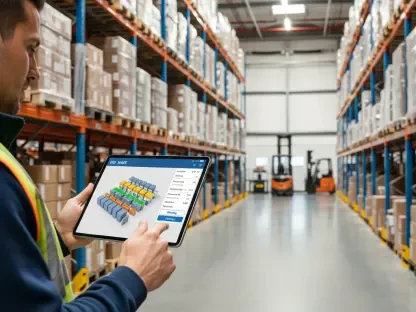The first half of 2024 has seen remarkable growth in China’s parcel delivery sector. With significant enhancements in service quality, infrastructure, and technology, the sector has managed to handle over 80 billion parcels from January to June. This expansion, generating express delivery revenue exceeding 640 billion yuan ($88.22 billion), underscores the dynamic evolution and impact of the parcel delivery industry on China’s broader economic and social development. The sector’s unprecedented growth not only reflects its capability to adapt to changing demands but also highlights its contributions to the national economy. As online shopping continues to surge, the demand for more efficient delivery services has never been higher. This rise in parcel volume demonstrates the sector’s significant role in supporting e-commerce, facilitating trade, and boosting overall consumer spending.
Enhanced Service Quality and Efficiency
The growth in China’s parcel delivery sector can largely be attributed to continuous improvements in service quality and operational efficiency. Companies within the industry have made substantial investments in upgrading their online systems, allowing for smoother and faster processing of parcels. This focus on enhancing service delivery has led to operational efficiencies that are critical in managing the vast volume of parcels. Furthermore, the integration of real-time tracking systems has increased transparency and customer satisfaction, ensuring that parcels are delivered promptly and accurately. This high level of service quality is a key factor driving consumer trust and loyalty, which in turn fuels further growth in the sector.
Connecting domestic and international markets has been a key focus, with notable advancements in the “going global” initiative. Efforts to improve the international parcel logistics system have resulted in steady growth in overseas business, proving beneficial for global trade. The optimization of network layouts and cross-border infrastructure has further boosted the capabilities of international hubs, ensuring efficient and reliable delivery services on a global scale. This global connectivity has been instrumental in supporting China’s robust export activities, facilitating trade relationships, and enhancing the country’s position in international markets. As companies continue to refine their logistics networks, the efficiency and reach of delivery services are expected to improve even further.
Technological Integration and Innovations
A significant factor driving the sector’s growth is the integration of advanced technologies. The adoption of artificial intelligence (AI), big data analytics, and automation has revolutionized how parcels are processed and delivered. These technologies have enhanced the precision, speed, and reliability of services, enabling the sector to meet the ever-growing demands of online shoppers. For instance, AI-powered sorting facilities and intelligent routing systems have allowed companies to optimize their logistics operations, drastically reducing delivery times and enhancing customer satisfaction. Big data analytics provide valuable insights into consumer behavior, helping businesses predict trends and manage resources more effectively.
The use of AI in sorting facilities and delivery routing allows companies to optimize their operations, reducing delivery times and enhancing customer satisfaction. Big data analytics help predict trends and manage logistics more efficiently, while automation in warehouses speeds up the entire process from sorting to dispatch. These technological advancements are crucial for maintaining competitiveness in a rapidly evolving market. As the industry continues to invest in cutting-edge technologies, it is expected to see further improvements in efficiency and service quality, ensuring that it can keep up with the growing demands of the digital economy. The ongoing innovation signifies a concerted effort to stay ahead in a highly competitive industry.
Cross-Border Infrastructure Improvements
China’s parcel delivery sector has made significant strides in enhancing cross-border infrastructure, which has been instrumental in its international growth. Investments in all-cargo aircraft fleets and the inauguration of multiple all-cargo flight routes have expanded delivery capabilities, especially for international shipments. These developments have not only improved delivery times but also ensured that parcels reach their destinations in a secure and reliable manner. The establishment of new trade routes and logistical collaborations with other countries have further strengthened China’s position as a global logistics hub, facilitating international trade and commerce.
The establishment of efficient transport routes, including the China-Europe freight train and land routes to Southeast Asia, has facilitated quicker and more reliable parcel delivery across borders. Maritime routes to the US West Coast have also been improved, ensuring that parcels reach their international destinations in a timely manner. These enhancements not only improve service quality but also strengthen China’s position in global logistics networks. By continuously upgrading its cross-border transport capabilities, the sector is better equipped to handle the increasing volume of international shipments, reinforcing its role as a critical component of global supply chains.
Economic and Social Impact
The rapid growth of the parcel delivery sector has had a profound impact on China’s economy and society. By supporting the thriving online economy, the sector has played a crucial role in driving consumer spending and e-commerce growth. This expansion has also created numerous job opportunities, contributing to social stability and economic prosperity. The sector’s ability to provide efficient logistics solutions has been especially beneficial for small and medium-sized enterprises (SMEs), allowing them to reach a wider customer base and compete more effectively in the market. As a result, the parcel delivery industry has become a vital enabler of economic growth and innovation.
As the industry continues to grow, it is expected to inject even more vitality into China’s broader economic landscape. The sector’s capacity to support small and medium-sized enterprises (SMEs) by providing efficient logistics solutions has been particularly noteworthy. These improvements allow SMEs to reach a wider customer base, fostering innovation and competition within the market. The increased connectivity and improved service quality offered by the parcel delivery sector have not only boosted e-commerce but also stimulated broader economic activities, from retail to manufacturing. This trend indicates the sector’s critical role in shaping China’s future economic trajectory.
Government and Policy Support
Government support and favorable policies have been pivotal in fostering the growth of China’s parcel delivery sector. Initiatives aimed at enhancing connectivity, promoting international business, and ensuring regulatory compliance have provided a conducive environment for the sector to thrive. These policies have enabled companies to invest in new technologies and expand their operations, driving overall sector growth. For instance, incentives for technological innovation and infrastructure development have encouraged companies to adopt advanced systems, improving service quality and operational efficiency. Government efforts to streamline regulations and reduce bureaucratic hurdles have also facilitated easier market entry and expansion for logistics companies.
Policies that encourage technological innovation and infrastructure development have been particularly effective in supporting the industry’s growth. By providing incentives and reducing barriers, the government has enabled companies to invest in new technologies and improve their service offerings. Looking ahead, continued policy support will be crucial for sustaining the sector’s upward trajectory and ensuring its long-term success. As the industry evolves, it will be essential for policymakers to remain responsive to emerging trends and challenges, ensuring that the regulatory framework continues to support innovation and growth. The alignment of industry goals with government initiatives will be key to maintaining the sector’s momentum and achieving sustainable development.
Challenges and Opportunities
Despite impressive growth, the parcel delivery sector faces several challenges that need addressing. The increasing volume of parcels demands continuous improvements in logistics and infrastructure to ensure efficient handling and timely delivery. Environmental concerns also necessitate the adoption of sustainable practices to reduce carbon emissions and minimize the sector’s ecological footprint. As the industry grows, it will be crucial to implement eco-friendly solutions like electric delivery vehicles and sustainable packaging materials to mitigate its environmental impact. Addressing these challenges is vital for ensuring the sector’s long-term sustainability and resilience.
Simultaneously, there are significant opportunities for further growth. Technological innovations, such as AI and automation, have the potential to enhance service quality and operational efficiency. Collaborations with international partners and integration into global logistics networks can strengthen the sector’s market position and international business. Leveraging these opportunities allows China’s parcel delivery sector to drive economic and social development both domestically and globally. The ability to innovate and adapt to changing market conditions will be instrumental in maintaining its competitive edge.
In conclusion, China’s parcel delivery sector showed robust growth and resilience in 2024, driven by improvements in service quality, infrastructure, and technology. This growth has significantly supported the online economy, contributing to China’s economic and social advancement. Despite the challenges, the sector has ample opportunities with advanced technological integration and government support. Continued focus on enhancing service quality, efficiency, and sustainability will further bolster the sector’s position, ensuring its upward trajectory. This cohesive narrative reflects the dynamic and evolving landscape of this vital industry, highlighting diverse perspectives and comprehensive developments.









